2019 Hyundai Tucson height
[x] Cancel search: heightPage 58 of 685
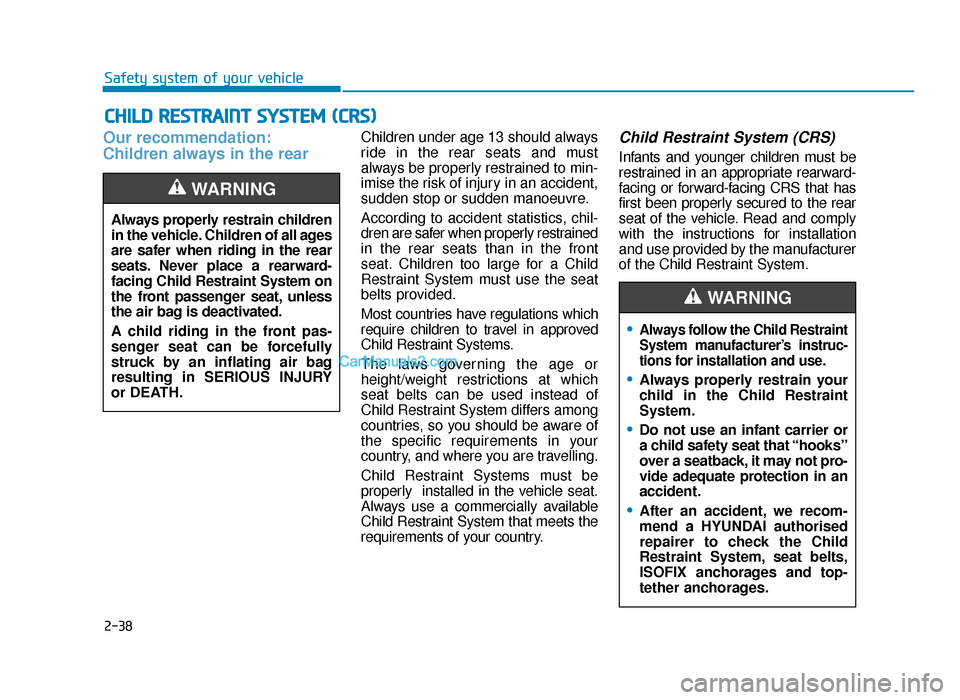
2-38
Safety system of your vehicle
Our recommendation:
Children always in the rear Children under age 13 should always
ride in the rear seats and must
always be properly restrained to min-
imise the risk of injury in an accident,
sudden stop or sudden manoeuvre.
According to accident statistics, chil-
dren are safer when properly restrained
in the rear seats than in the front
seat. Children too large for a Child
Restraint System must use the seat
belts provided.
Most countries have regulations which
require children to travel in approved
Child Restraint Systems.
The laws governing the age or
height/weight restrictions at which
seat belts can be used instead of
Child Restraint System differs among
countries, so you should be aware of
the specific requirements in your
country, and where you are travelling.
Child Restraint Systems must be
properly installed in the vehicle seat.
Always use a commercially available
Child Restraint System that meets the
requirements of your country.Child Restraint System (CRS)
Infants and younger children must be
restrained in an appropriate rearward-
facing or forward-facing CRS that has
first been properly secured to the rear
seat of the vehicle. Read and comply
with the instructions for installation
and use provided by the manufacturer
of the Child Restraint System.
CHILD RESTRAINT SYSTEM (CRS)
Always properly restrain children
in the vehicle. Children of all ages
are safer when riding in the rear
seats. Never place a rearward-
facing Child Restraint System on
the front passenger seat, unless
the air bag is deactivated.
A child riding in the front pas-
senger seat can be forcefully
struck by an inflating air bag
resulting in SERIOUS INJURY
or DEATH.
WARNING
•Always follow the Child Restraint
System manufacturer’s instruc-
tions for installation and use.
•Always properly restrain your
child in the Child Restraint
System.
•Do not use an infant carrier or
a child safety seat that “hooks”
over a seatback, it may not pro-
vide adequate protection in an
accident.
•After an accident, we recom-
mend a HYUNDAI authorised
repairer to check the Child
Restraint System, seat belts,
ISOFIX anchorages and top-
tether anchorages.
WARNING
TLe UK 2.qxp 6/12/2018 2:07 PM Page 38
Page 59 of 685
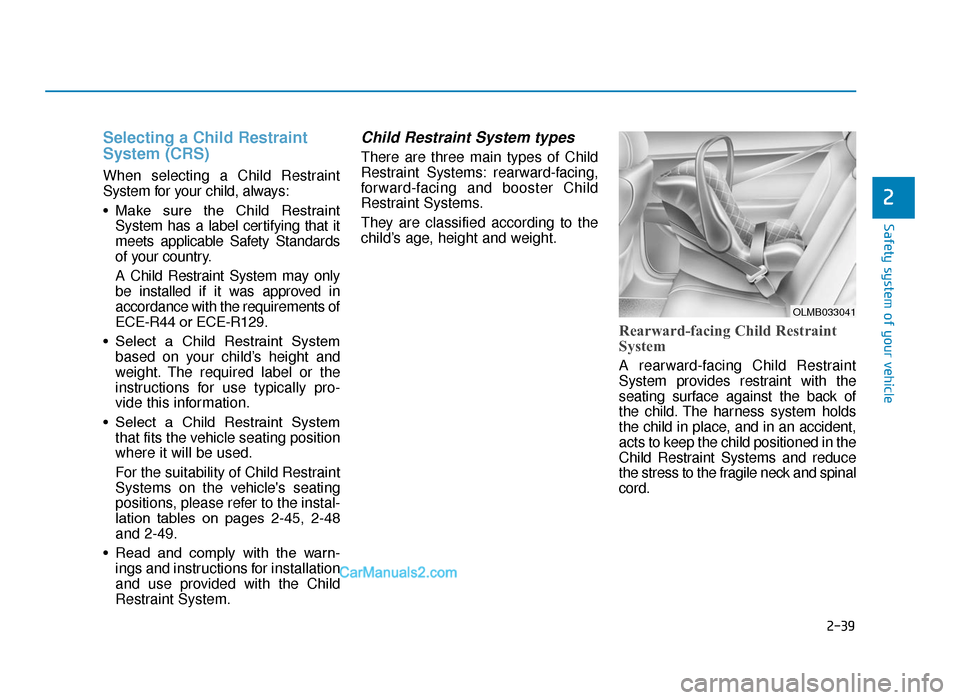
2-39
Safety system of your vehicle
2
Selecting a Child Restraint
System (CRS)
When selecting a Child Restraint
System for your child, always:
• Make sure the Child RestraintSystem has a label certifying that it
meets applicable Safety Standards
of your country.
A Child Restraint System may only
be installed if it was approved in
accordance with the requirements of
ECE-R44 or ECE-R129.
• Select a Child Restraint System based on your child’s height and
weight. The required label or the
instructions for use typically pro-
vide this information.
• Select a Child Restraint System that fits the vehicle seating position
where it will be used.
For the suitability of Child Restraint
Systems on the vehicle's seating
positions, please refer to the instal-
lation tables on pages 2-45, 2-48
and 2-49.
• Read and comply with the warn- ings and instructions for installation
and use provided with the Child
Restraint System.
Child Restraint System types
There are three main types of Child
Restraint Systems: rearward-facing,
forward-facing and booster Child
Restraint Systems.
They are classified according to the
child’s age, height and weight.
Rearward-facing Child Restraint
System
A rearward-facing Child Restraint
System provides restraint with the
seating surface against the back of
the child. The harness system holds
the child in place, and in an accident,
acts to keep the child positioned in the
Child Restraint Systems and reduce
the stress to the fragile neck and spinal
cord.
OLMB033041
TLe UK 2.qxp 6/12/2018 2:07 PM Page 39
Page 60 of 685
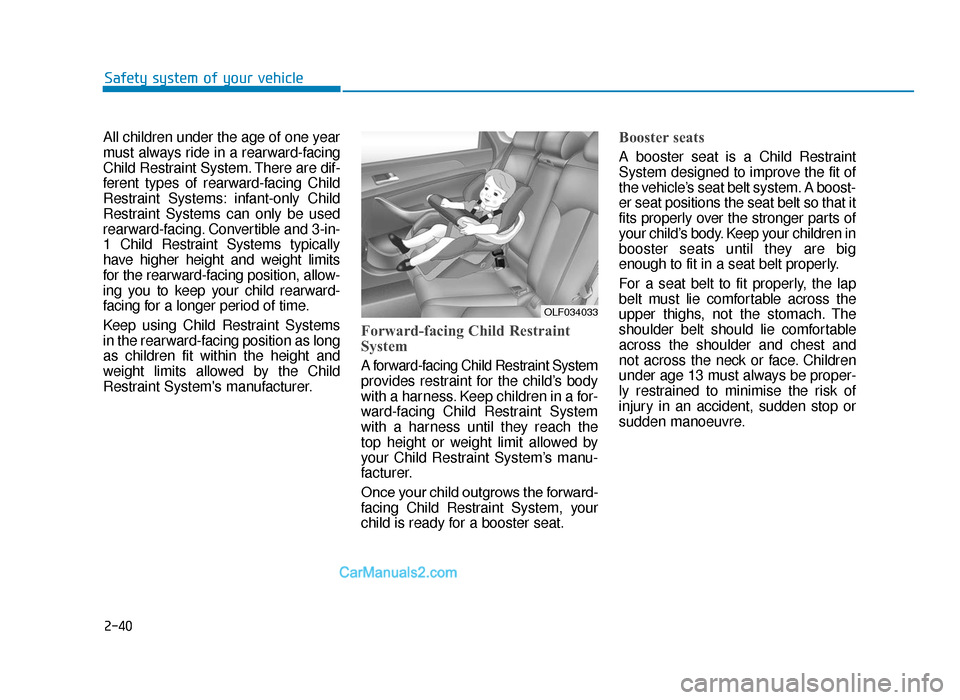
2-40
Safety system of your vehicle
All children under the age of one year
must always ride in a rearward-facing
Child Restraint System. There are dif-
ferent types of rearward-facing Child
Restraint Systems: infant-only Child
Restraint Systems can only be used
rearward-facing. Convertible and 3-in-
1 Child Restraint Systems typically
have higher height and weight limits
for the rearward-facing position, allow-
ing you to keep your child rearward-
facing for a longer period of time.
Keep using Child Restraint Systems
in the rearward-facing position as long
as children fit within the height and
weight limits allowed by the Child
Restraint System's manufacturer.
Forward-facing Child Restraint
System
A forward-facing Child Restraint System
provides restraint for the child’s body
with a harness. Keep children in a for-
ward-facing Child Restraint System
with a harness until they reach the
top height or weight limit allowed by
your Child Restraint System’s manu-
facturer.
Once your child outgrows the forward-
facing Child Restraint System, your
child is ready for a booster seat.
Booster seats
A booster seat is a Child Restraint
System designed to improve the fit of
the vehicle’s seat belt system. A boost-
er seat positions the seat belt so that it
fits properly over the stronger parts of
your child’s body. Keep your children in
booster seats until they are big
enough to fit in a seat belt properly.
For a seat belt to fit properly, the lap
belt must lie comfortable across the
upper thighs, not the stomach. The
shoulder belt should lie comfortable
across the shoulder and chest and
not across the neck or face. Children
under age 13 must always be proper-
ly restrained to minimise the risk of
injury in an accident, sudden stop or
sudden manoeuvre.
OLF034033
TLe UK 2.qxp 6/12/2018 2:07 PM Page 40
Page 65 of 685
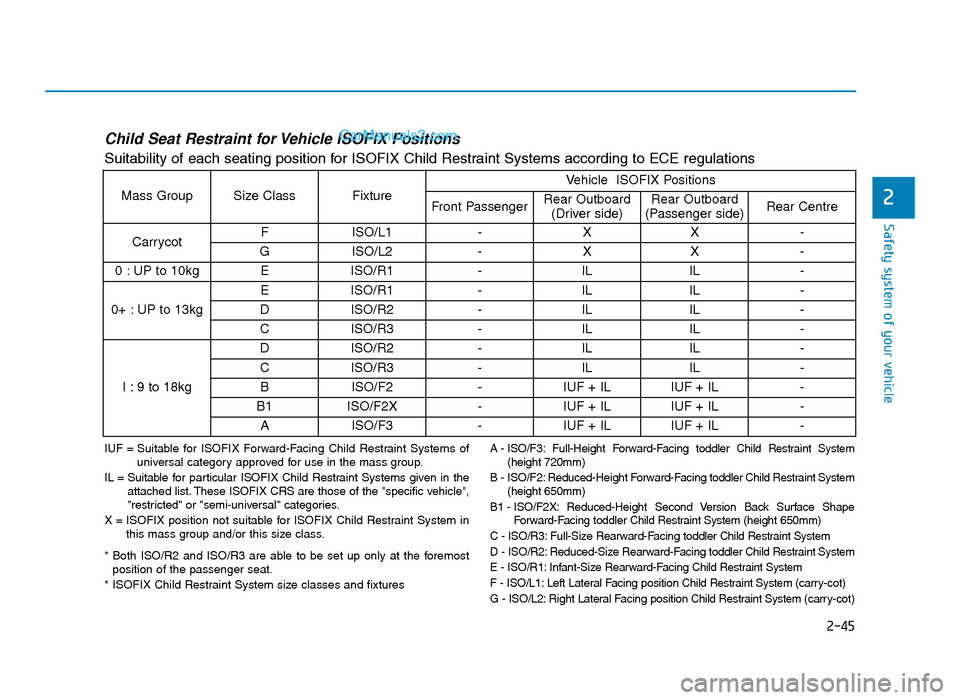
2-45
Safety system of your vehicle
2
Child Seat Restraint for Vehicle ISOFIX Positions
Suitability of each seating position for ISOFIX Child Restraint Systems according to ECE regulations
IUF = Suitable for ISOFIX Forward-Facing Child Restraint Systems ofuniversal category approved for use in the mass group.
IL = Suitable for particular ISOFIX Child Restraint Systems given in the attached list. These ISOFIX CRS are those of the "specific vehicle",
"restricted" or "semi-universal" categories.
X = ISOFIX position not suitable for ISOFIX Child Restraint System in this mass group and/or this size class.
* Both ISO/R2 and ISO/R3 are able to be set up only at the foremost position of the passenger seat.
* ISOFIX Child Restraint System size classes and fixturesA - ISO/F3: Full-Height Forward-Facing toddler Child Restraint System(height 720mm)
B - ISO/F2: Reduced-Height Forward-Facing toddler
Child Restraint System(height 650mm)
B1 - ISO/F2X: Reduced-Height Second Version Back Surface Shape Forward-Facing toddler
Child Restraint System(height 650mm)
C - ISO/R3: Full-Size Rearward-Facing toddler
Child Restraint System
D - ISO/R2: Reduced-Size Rearward-Facing toddler Child Restraint System
E - ISO/R1: Infant-Size Rearward-Facing Child Restraint System
F - ISO/L1: Left Lateral Facing position Child Restraint System(carry-cot)
G - ISO/L2: Right Lateral Facing position
Child Restraint System(carry-cot)
Mass Group Size Class Fixture Vehicle ISOFIX Positions
Front Passenger Rear Outboard
(Driver side) Rear Outboard
(Passenger side) Rear Centre
Carrycot F
ISO/L1 -X X -
G ISO/L2 -X X -
0 : UP to 10kg E ISO/R1-IL IL -
0+ : UP to 13kg E
ISO/R1 -IL IL -
D ISO/R2 -IL IL -
C ISO/R3 -IL IL -
I : 9 to 18kg D
ISO/R2 -IL IL -
C ISO/R3 -IL IL -
B ISO/F2 -IUF + IL IUF + IL -
B1 ISO/F2X -IUF + IL IUF + IL -
A ISO/F3 -IUF + IL IUF + IL -
TLe UK 2.qxp 6/12/2018 2:07 PM Page 45
Page 89 of 685
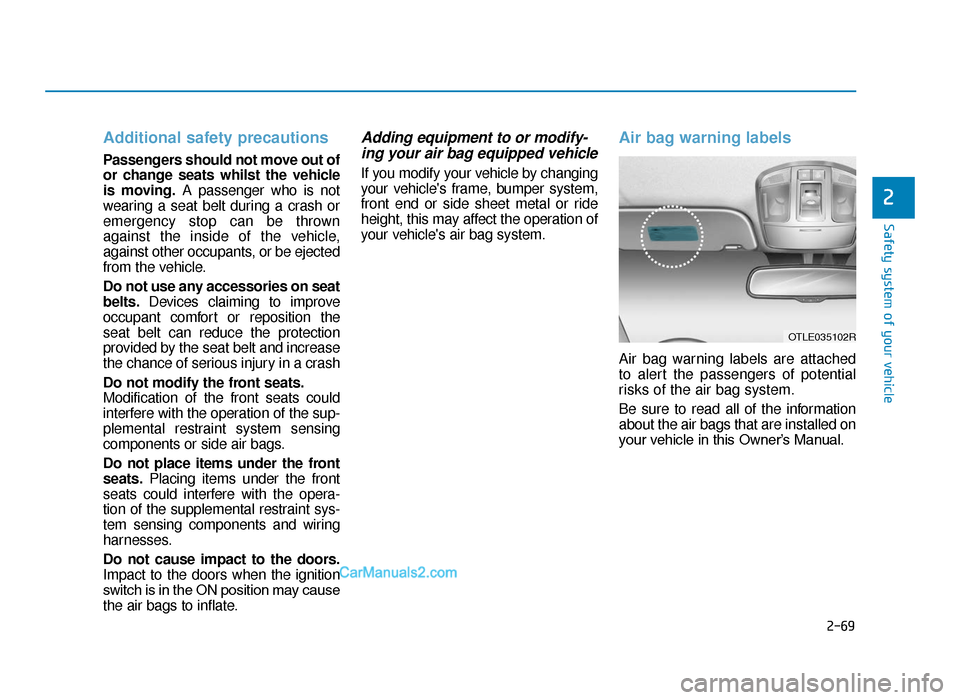
2-69
Safety system of your vehicle
2
Additional safety precautions
Passengers should not move out of
or change seats whilst the vehicle
is moving.A passenger who is not
wearing a seat belt during a crash or
emergency stop can be thrown
against the inside of the vehicle,
against other occupants, or be ejected
from the vehicle.
Do not use any accessories on seat
belts. Devices claiming to improve
occupant comfort or reposition the
seat belt can reduce the protection
provided by the seat belt and increase
the chance of serious injury in a crash
Do not modify the front seats.
Modification of the front seats could
interfere with the operation of the sup-
plemental restraint system sensing
components or side air bags.
Do not place items under the front
seats. Placing items under the front
seats could interfere with the opera-
tion of the supplemental restraint sys-
tem sensing components and wiring
harnesses.
Do not cause impact to the doors.
Impact to the doors when the ignition
switch is in the ON position may cause
the air bags to inflate.
Adding equipment to or modify- ing your air bag equipped vehicle
If you modify your vehicle by changing
your vehicle's frame, bumper system,
front end or side sheet metal or ride
height, this may affect the operation of
your vehicle's air bag system.
Air bag warning labels
Air bag warning labels are attached
to alert the passengers of potential
risks of the air bag system.
Be sure to read all of the information
about the air bags that are installed on
your vehicle in this Owner’s Manual.
OTLE035102R
TLe UK 2.qxp 6/12/2018 2:09 PM Page 69
Page 147 of 685

3-55
Convenient features of your vehicle
Power tailgate opening heightuser setting
The driver may set the height of a
fully opened tailgate by following the
below instruction.
1. Position the tailgate manually to
the height you prefer.
2. Press the power tailgate inner switch for more than 3 seconds.
3. Close the tailgate manually after hearing the buzzer sound.
The tailgate will open to the height
the driver has set up.
Emergency tailgate safety release
Your vehicle is equipped with the
emergency tailgate safety release
lever located on the bottom of the
tailgate. When someone is inadver-
tently locked in the luggage compart-
ment, the tailgate can be opened by
doing as follows:
1. Remove the cover.
2. Push the release lever to the right.
3. Push up the tailgate.
3
OTLE048041OTLE048038
Always keep the tailgate com-
pletely closed whilst the vehicle
is in motion. If it is left open or
ajar, poisonous exhaust gases
containing carbon monoxide
(CO) may enter the vehicle and
serious illness or death may
result.
WARNING
Occupants should never ride in
the rear cargo area where no
restraints are available. To avoid
injury in the event of an accident
or sudden stops, occupants
should always be properly
restrained.
WARNING
TLe UK 3a(~109).qxp 6/12/2018 2:25 PM Page 55
Page 223 of 685
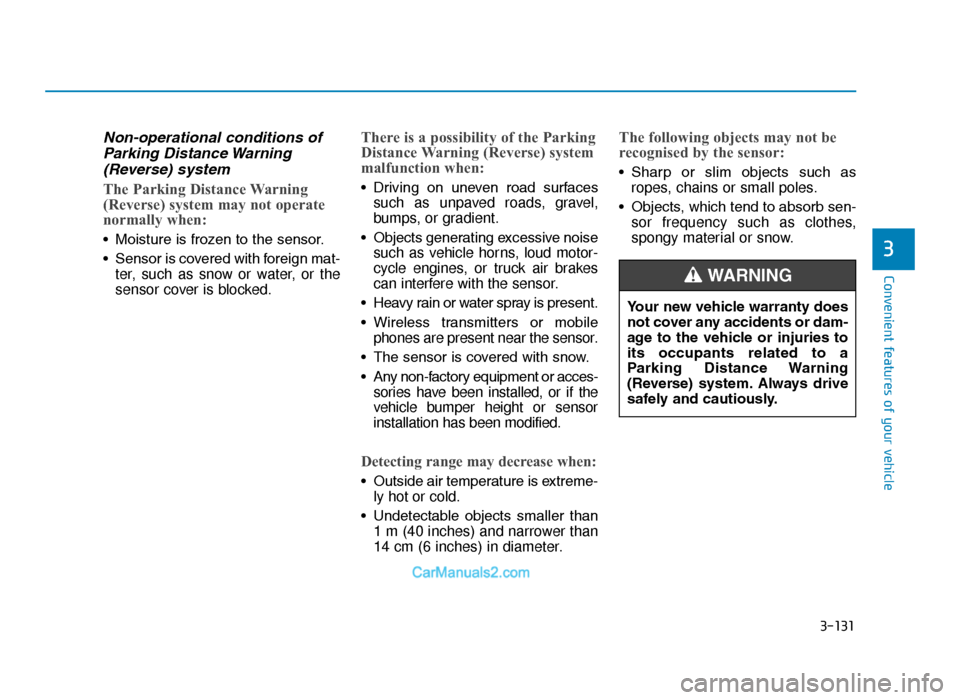
3-131
Convenient features of your vehicle
3
Non-operational conditions ofParking Distance Warning(Reverse) system
The Parking Distance Warning
(Reverse) system may not operate
normally when:
• Moisture is frozen to the sensor.
• Sensor is covered with foreign mat-
ter, such as snow or water, or the
sensor cover is blocked.
There is a possibility of the Parking
Distance Warning (Reverse) system
malfunction when:
• Driving on uneven road surfacessuch as unpaved roads, gravel,
bumps, or gradient.
• Objects generating excessive noise such as vehicle horns, loud motor-
cycle engines, or truck air brakes
can interfere with the sensor.
• Heavy rain or water spray is present.
• Wireless transmitters or mobile phones are present near the sensor.
• The sensor is covered with snow.
• Any non-factory equipment or acces- sories have been installed, or if the
vehicle bumper height or sensor
installation has been modified.
Detecting range may decrease when:
• Outside air temperature is extreme-ly hot or cold.
• Undetectable objects smaller than 1 m (40 inches) and narrower than
14 cm (6 inches) in diameter.
The following objects may not be
recognised by the sensor:
• Sharp or slim objects such asropes, chains or small poles.
• Objects, which tend to absorb sen- sor frequency such as clothes,
spongy material or snow.
Your new vehicle warranty does
not cover any accidents or dam-
age to the vehicle or injuries to
its occupants related to a
Parking Distance Warning
(Reverse) system. Always drive
safely and cautiously.
WARNING
TLe UK 3b(110~).qxp 6/12/2018 2:37 PM Page 131
Page 224 of 685
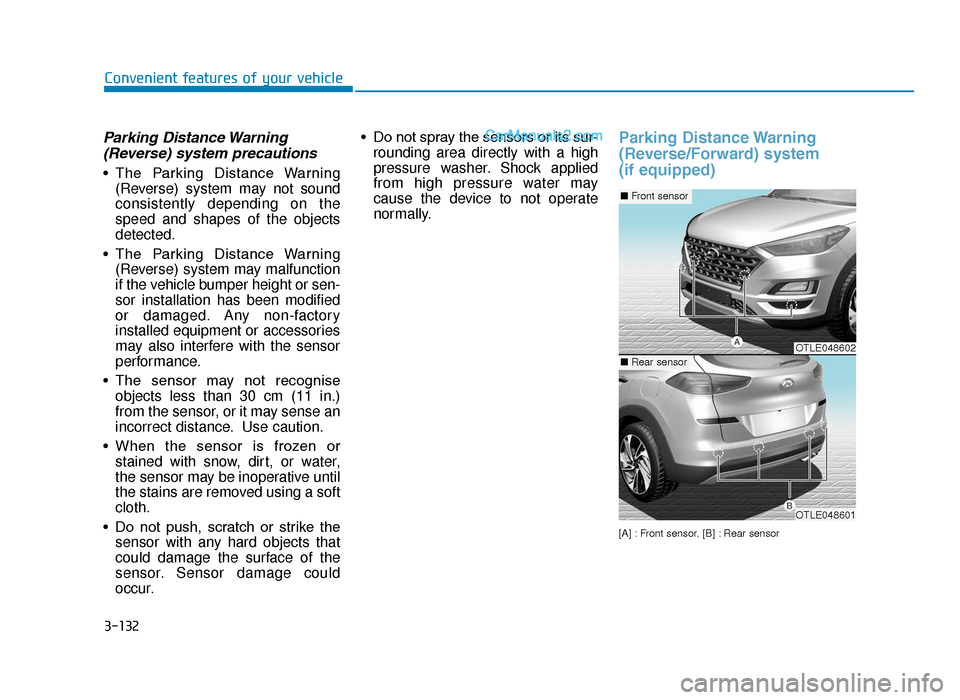
3-132
Convenient features of your vehicle
Parking Distance Warning(Reverse) system precautions
• The Parking Distance Warning
(Reverse) system may not sound
consistently depending on the
speed and shapes of the objects
detected.
• The Parking Distance Warning (Reverse) system may malfunction
if the vehicle bumper height or sen-
sor installation has been modified
or damaged. Any non-factory
installed equipment or accessories
may also interfere with the sensor
performance.
• The sensor may not recognise objects less than 30 cm (11 in.)
from the sensor, or it may sense an
incorrect distance. Use caution.
• When the sensor is frozen or stained with snow, dirt, or water,
the sensor may be inoperative until
the stains are removed using a soft
cloth.
• Do not push, scratch or strike the sensor with any hard objects that
could damage the surface of the
sensor. Sensor damage could
occur. • Do not spray the sensors or its sur-
rounding area directly with a high
pressure washer. Shock applied
from high pressure water may
cause the device to not operate
normally.
Parking Distance Warning
(Reverse/Forward) system
(if equipped)
[A] : Front sensor, [B] : Rear sensor
OTLE048602
OTLE048601
■ Front sensor
■Rear sensor
TLe UK 3b(110~).qxp 6/12/2018 2:37 PM Page 132